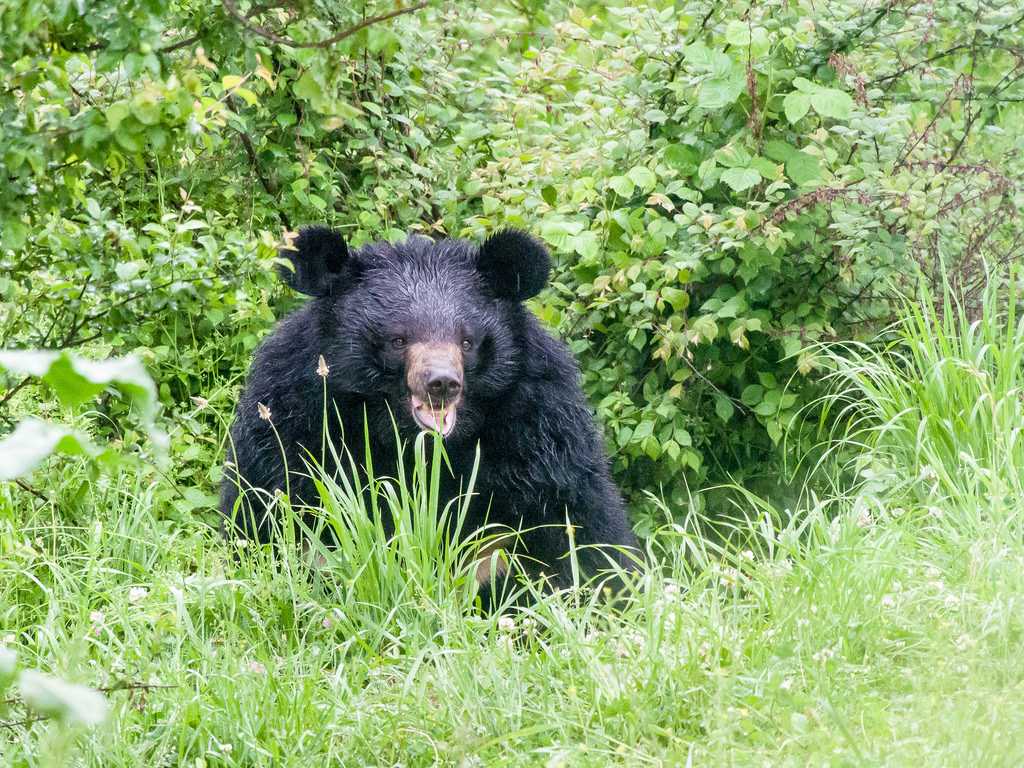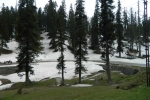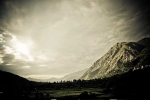Dachigam National Park Tourism
Hills Valleys, Rivers Lakes, National Parks,
Ideal Duration : 1 day
Best Time : April to October
Dachigam National Park Tourism
You have come here with one motive, and that is to explore and experience the sheer beauty that this splendid National Park beholds within itself. The lush green environs, beautiful flora and some of the rarest fauna species are to found here in this park.
The park is best known for having the rarest of species - the hangul, or Kashmir stag. It is India's most elevated forest reserve at an altitude of 1,700 m. to 4,300 m. above sea level and is spread over a sprawling 141 sq kms. Right from the Himalayan grey langur that feed on the barks of trees to the rare Himalayan brown bear to Pygmy Owlets to the predators, the leopards. You shall not be disappointed one bit because Dachigam is always prepared to show you all of its beauty, all you have to do is sit back and enjoy.
Dachigam National Park, Jammu & Kashmir is situated at a mere 22 kms from the main town of Srinagar. Dachigam literally stands for 'ten villages', which is kept in memory of the ten villages that had to be relocated in order to create the catchment area and the park.
Download Dachigam National Park PDF Guide >
What's Great?
It is breathtaking. It can be visited all year round. It has a broad range of flora and fauna and is the home of the endangered Kashmir Stag and the snow leopard.
What's not so Great?
It is located in Kashmir which is a troubled state. Political unrest has caused a lot of problems for this park.
For Whom
It is an ideal place for wildlife enthusiasts, adventurers and anybody who wants to escape the dull daily life.
About Dachigam National Park
The name Dachigam means 'ten villages' in the memory of ten villages that were relocated to make the park. The park is divided into two sectors, upper and lower. The park is the habitat of the endangered Hangul or Kashmir Stag- the only species of Red Deer to be found in India. Other inhabitants include the Himalayan black bear, species of exotic Himalayan birds. The elusive snow leopard is also found at the higher altitude and the only predator. Other animals that can be spotted are rare musk deer and the Himalayan marmot. The magnificent golden eagle and vulture and seen soaring skies.
Sangargulu Valley
If you are hardcore enthusiast of wild animals and just cannot do with getting a glimpse of the deer, langurs and bears then Sangargulu Valley is the trek you've long awaited for.
This is a trek solely dedicated to finding wildlife that cannot be easily found. One has a great chance to spot the leopards here and the koklas pheasants in Gretnar.
Permit
You need special permits from the wildlife office to visit this area. It remains open from 10:00 AM to 05:00 PM every day and the entry fee is INR 25 per person. Private vehicles are not allowed inside.
Habitat
Like all other forests, Dachigam is also so much more than a home to trees. A thick cover of alpine trees, pristine waterfalls, widespread shrubland, and flowery meadows straight out of enchanted tales make up this wilderness which is the habitat of some of the fascinating bird and animal species.
Except during winters, the meadows are overrun with a variety of flowers, giving it a splash of colours. Wild cherry, peach, plum, apple, apricot, and walnut trees paint the very picture of abundance when laden with fruit.
Oak, Birch, Pine, Elm, Chinar, Willow, and Poplar trees add specks of vivid hues of Green.
Marsar lake inside the park is a popular fishing spot, brimming with Trout fish.
Wildlife
Dachigam National Park is most famous for being home to Hangul or Red deer, an elk species native to India. Hangul is the state animal of Kashmir, well known for its spectacular antlers which can have as many as 16 points. Its population is majorly concentrated in Dachigam and early mornings are the best time for catching a glimpse of the now endangered species.
Dachigam also shelters numerous other wildlife species, like the leopard, musk deer, black and brown bears, common palm civet, jackal, red fox, yellow-throated marten, long-tailed marmot, and Himalayan weasel. The pearly white snow leopard, with its lustrous silver coat, is found in higher altitudes at Dachigam.
It?s cold and pristine, but that does not mean an absence of avifauna. Brilliantly coloured monal pheasant and blue magpie trotter about in these jungles. The bearded vulture which feeds on bones for its meals also ventures around and about here.
Trekking for Sightseeing
Located in the Zabarwan range of Western Himalayas, Dachigam is a landscape of sharp contrast. The park is divided into lower and upper Dachigam, with marked differences in terrain, altitude, flora, and fauna. If you are a trekker, then this park has great potential for exploration on foot. Lower Dachigam has an elevation of 1700 metres with a gentle ascent. It's most suitable for the casual trekker. It covers one-third of the total park area with a thick canopy of Alpine trees. A 10 km long trek will bring you to middle Dachigam and usher you into a thicker, more diverse cover of rich flora. This is where you start noticing changes in the terrain which is about to become harsh, jagged, and rocky. Upper Dachigam, with an elevation of 4300 metres, is not for the faint of heart or the occasional trekker. But, for the seasoned trekking enthusiast, it offers an exhilarating experience. It takes at least a day to reach Upper Dachigam from the nearest road, and you need special permits for your trek here. Be prepared for an unforgiving and challenging terrain with harsh weather conditions as you gear up for the trek of a lifetime.
One Day Itinerary
For visiting Dachigam, you must firstly choose a primary location. If it is Srinagar, you must leave for Dachigam National Park early morning at 6:30 AM. Experience the wildlife and the scenic beauty that this place has to offer. Leave for Srinagar at 5:00 PM. If you choose to stay in Dachigam itself, you must still wake up this early in order to experience the beauty of this place at its fullest.
Restaurants and Local Food in Dachigam National Park
There aren't any food joints in Dachigam itself, so if you're staying in the dorms of Dachigam do not forget to carry food packets for yourself. Otherwise, there are a lot of options and cuisines in the city of Srinagar. The Mughlai and North Indian, mainly Punjabi cuisines predominate here. Non veg is available in majority of the restaurants here.
View 5 Restaurants in Dachigam National Park >>
Apr-Octis the best time to visit Dachigam National Park
April-October is the best months to be in this place. In winters, the upper part of the National Park is entirely covered in snow which makes it totally inaccessible, and the temperature in the lower region also drops down to -10 degrees Celcius which would be a highly unfavourable time for tourists. The best time would thus be between April to October i.e. the summer season. During these months one will be able to find full grown lush green trees, and it is also this period that is the most appropriate for bird watching.
Weather in Dachigam National Park
Loading...
Dachigam National Park in Summer (April - August)
Lower and Upper Dachigam are at their best between June and August. Summer is also a good time to visit the lower areas.
Dachigam National Park in Autumn (September - November)
Probably the best month is October when the rutting season is on, and Kashmir's glorious autumn tree colours are in evidence. September/October is also a good time for viewing the Black Bear which is feeding up on the remaining walnuts and acorns, building up fat for its long hibernation.
Dachigam National Park in Winter (December - March)
The upper areas are not easily accessible in the winter months. Lower Dachigam is open, but it is better to avoid Dachigam during the winter months, due to the snow and extreme climatic conditions.
Dachigam National Park in
If you are hardcore enthusiast of wild animals and just cannot do with getting a glimpse of the deer, langurs and bears then Sangargulu Valley is the trek you've long awaited for.
This is a trek solely dedicated to finding wildlife that cannot be easily found. One has a great chance to spot the leopards here and the koklas pheasants in Gretnar.
Monthly Weather in Dachigam National Park
Month
Avg. Minimum (°C)
Avg. Maximum (°C)
January
2
17
February
5
22
March
8
26
April
12
34
May
16
37
June
18
38
July
21
29
August
20
28
September
17
28
October
11
29
November
5
25
December
2
23
Comments on Dachigam National Park
Post Your Comment


 Srinagar
Srinagar Sonamarg
Sonamarg Pahalgam
Pahalgam Gulmarg
Gulmarg Amarnath
Amarnath Manali
Manali